|
|
|
| My Favourite Planet > English > People > Dioskourides of Samos |
 |
back |
Dioskourides of Samos |
|
|
| |
Dioskourides of Samos
Dioskourides of Samos (Διοσκουρίδης Σάμιος; Latin, Dioscurides) is thought to have been mosaic artist working in the late 2nd to early 1st century BC.
Two small mosaic emblemata (panels) found in 1763 and 1764 [1] in the "Villa of Cicero", outside the Herculaneum Gate at the west of Pompeii, are signed:
ΔΙΟΣΚΟΥΡΙΔΗΣ ΣΑΜΙΟΣ ΕΠΟΙΗΣΕ
(Dioskourides Samios epoese)
Dioskourides of Samos created [this]
It is not known whether Dioskourides was the name of the maker of the mosaics or the artist who made the original works, perhaps Hellenistic paintings of the early third century BC, of which they may be copies. [2] Apart from these two works nothing else is known about him.
The first mosaic depicts what appears to be a group of street musicians wearing theatrical masks (see photos and details below). The second shows a group of three women, also wearing actor's masks, sitting around a table (see photos and details below). This image has been interpreted as women consulting a witch, sorceress, fortune teller, matchmaker or procuress, represented by the older woman on the right. It has even been suggested that the old woman is preparing a philter (magic love potion).
From the time of their discovery it was clear to scholars that both mosaics depicted scenes from plays, as other ancient representations of theatrical works in frescoes, mosaics and reliefs were being discovered at Pompeii, Herculaneum and elsewhere. Further scrutiny of the mosaics pointed to works of the Attic New Comedy of the fourth century BC, and particularly to Menander of Athens (Μένανδρος, circa 342-290 BC), the most famous playwright of the genre. Knowledge of his reputation rested mainly on mentions of his works and quotations by ancient authors, but nearly all of his plays had been lost, and it was not until the beginning of the 20th century that the first fragments of papyrus manuscripts were discovered.
In 1930 the German classical philologist Friedrich Marx (1859-1941) was the first to propose that the mosaic of the women at the table was a scene from a lost play of Menander on which the Roman playwright Titus Maccius Plautus (circa 254-184 BC) based his comedy Cistellaria (Casket Comedy). This was later confirmed and the work of Menander was subsequentally identified as Synaristosai (Συναριστῶσαι, Women at lunch or The women who lunch together). [3]
Mosaics of the late third century AD, found in 1961-1962 in the "House of Menander" at Mytilene (Lesbos), depict almost identical scenes, and the accompanying inscriptions identify them as being from comedies by Menander. According to the inscriptions, the scene of the musicians is from the play Theophoroumene (Θεοφορουμένη, The girl possessed by a deity), and that of the seated women from Synaristosai. [4] Only fragments of these two comedies have survived.
Such mosaic panels, known as emblemata (singular, emblema), where - and still are - prepared in the mosaic artists' studios, before being taken to be cemented to the customers' floors or walls. Small emblemata can be easily carried whole, whereas larger motifs must be divided into sections for transportation. Although it is thought that many mosaics were made by artists and their assistants travelling to the various locations, it is also possible that such mosaics could also be made for or sold to customers in other regions and countries.
Whether the maker of these mosaics lived or worked at Pompeii is unknown. If he was the creator of these images, rather than being just a copyist of famous works, then his reputation allowed him to sign the panels. In this case he may well have been living elsewhere and his works bought by wealthy clients abroad. |
| |
| |
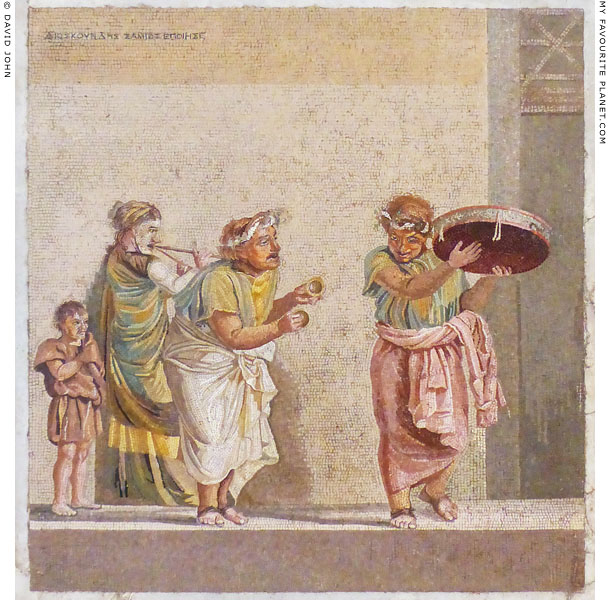
Mosaic panel depicting "street musicians" ("Musici Ambulanti"), signed by Dioskourides of Samos.
A scene from Menander's comedy play Theophoroumene (The Girl Possessed by a God).
See also a fresco painting of the same scene below.
Polychrome floor mosaic, made with stone tesserae, using the opus vermiculatum
(Latin, worm-like work) technique. Found 28 April 1763 in the "Villa of Cicero", Pompeii.
Height 43.7 cm, width 41.7 cm.
National Archaeological Museum, Naples. Inv. No. 9985. |
| |
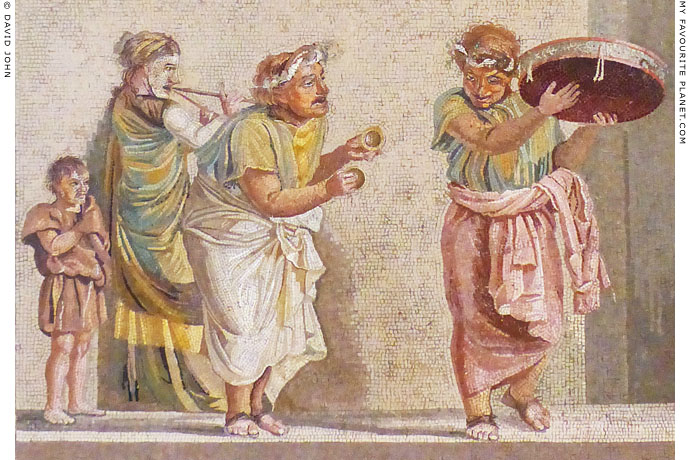
Detail of the musicians in the mosaic above.
|
This mosaic emblema and the other signed by Dioskourides of Samos (see below) are finely detailed, surprisingly realistic works made of small (between 0.5 and 2.5 mm), well-cut, tightly-fitted stone tesserae. The colour schemes of both are lively but restrained, using subtly shaded yellows, greens, pinks, reds and browns, black, grey and white. The mortar behind and between the tesserae was tinted to match the colours of the stones in order to enhance the smoothness of the shading. This feature can be seen clearly in places were tesserae are now missing.
The image shows a group of four people on what appears to be a street, suggested simply by a plain wall and part of a doorway on the right. However, the setting may be a stage and the door the central entrance of the skene (stage building).
On the left stands a small figure, thought to be a child or a dwarf, because of a hint of a beard; and perhaps a slave, because of his simple, drab chiton (tunic) and unkempt hair. It has been suggested that in his right hand he is holding a case for a pipe, although what appears to be a sausage-shaped object to the left side of his chest is not well defined or differentiated in form or colour, and could as well be a fold in his tunic or part of his left forearm.
The other three figures are more richly dressed in chitons and himatia (cloaks), wear theatrical masks and play musical instruments. The musician on the left wears a woman's hair, mask and clothing, and plays the double pipes (aulos). The other two male figures to the right and in front of the "woman" wear wreaths and sandals, and have their himatia tied around their waists. The central musician plays small cymbals, and the third holds a large tympanon (frame drum) in his left hand and taps its underside with his right hand. Both male figures appear to be dancing to the music, or perhaps stamping the beat. [5]
The male musicians have been tentatively identified as the youths Lysias (cymbals) and Kleinias, two of the characters subtitled in the Mytilene mosaic inscription and mentioned in a papyrus fragment of the play (PSI 1280). The female aulos player has been interpreted as a hetaera (courtesan). The musicians may have been associated with the cult of the Phrygian mother goddess Kybele. Surviving fragments of Meander's comedy Theophoroumene (Θεοφορουμένη, The girl possessed by a deity) indicate that the girl is possessed by Kybele, whose cult rituals included ecstatic states and dances performed to drums and cymbals. [6] |
|
|
| |

The signature of Dioskourides of Samos on the mosaic of musicians above.
"ΔΙΟΣΚΟΥΡΙΔΗΣ ΣΑΜΙΟΣ ΕΠΟΙΗΣΕ" (Dioskourides Samios epoese, Dioskourides of Samos made it).
The signature, made of small pieces of terracotta, is at the top left of the emblema,
in a band of tesserae a shade darker than the rest of the wall behind the figures.
This band may represent the shadow of the roof of the building. |
| |

A fresco painting of "ambulant musicians" ("Pittura con attori"). Fourth Style. Circa 30-40 AD (?).
Found in 1774 at the Villa in Campa Varano, Stabiae (5 km south of Pompeii).
Height 21 cm, width 31 cm.
National Archaeological Museum, Naples. Inv. No. 9034.
|
The scene, the figures and the composition are almost identical to those of the mosaic above, although the small "slave" figure on the left has placed been further away from the musicians.
It has been suggested (e.g. Bieber and Rodenwaldt, see note 1) that the painting and the mosaics from the "House of Menander" in Mytilene may be copies of the works signed by Dioskourides. It is just as likely that the Dioskourides mosaics themselves are copies of earlier works. The "frame" around this painting is also painted on the plaster, which may indicate that the work was copied from a painting.
Over nearly 2000 years the painting has lost much of its freshness, the paint has faded and flaked off. The mosaic, in comparison, still looks fresh, lively, dynamic and more convincingly realistic. |
|
|
| |
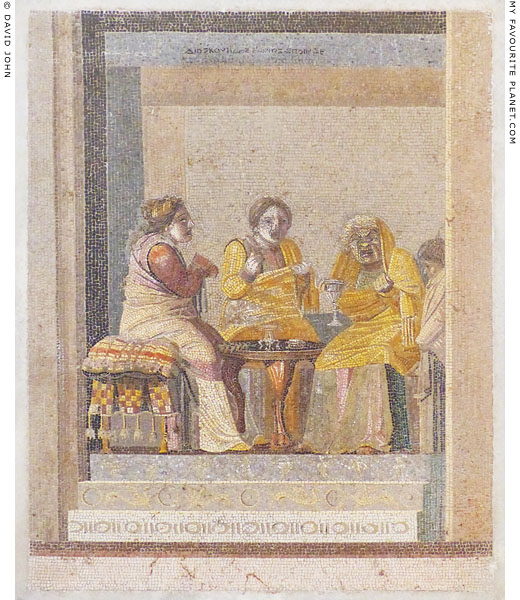
Mosaic panel depicting women sitting around a table, signed by Dioskourides of Samos.
A scene from Act 1 of the comedy play Synaristosai (Women at lunch) by Menander.
Polychrome floor mosaic, made with stone tesserae, using the opus vermiculatum technique.
Found 8 February 1764 in the "Villa of Cicero", Pompeii. Height 42 cm, width 33 cm.
National Archaeological Museum, Naples. Inv. No. 9987. |
| |
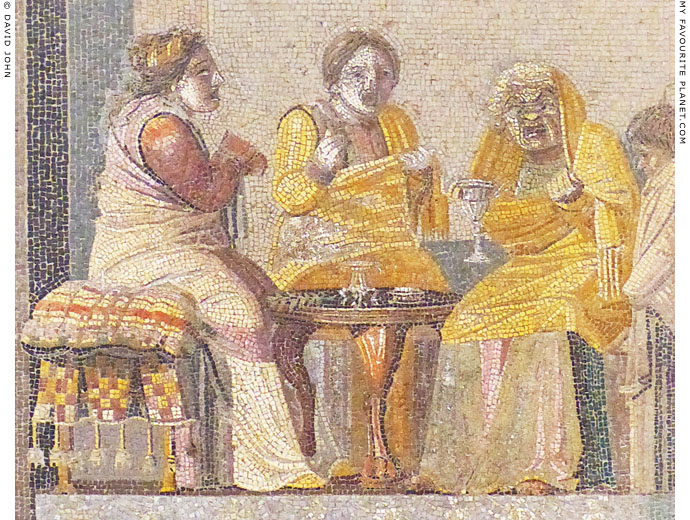
Detail of the women in the mosaic above.
|
Three well-dressed women sit around a small, round-topped table on which stand what appear to be a laurel twig, a drinking vessel or thymiaterion (incense burner), and a small pyxis (box).
The woman on the left, seen in profile, is seated on a stool with a tassled cover beneath a cushion. All three wear masks (this figure's mask is more obvious) with open mouths, giving the impression they are talking, praying, singing or chanting. The "women", then, were actually male actors.
They all have raised forearms, although the gesture this is meant to convey is not apparent. The figure in the centre and the white-haired, older woman on the right both wear yellow top garments. The latter's head is covered (veiled) by part of her cloak, and she holds a silver kantharos (drinking cup) in her right hand.
In the Mytilene mosaic version of this scene [see note 4], in which the figures are shown in reverse order, inscriptions identify the characters. In this mosaic the characters, from left to right, are: Pythias, Plangon and Philainis (the old woman). In the Roman comedy Cistellaria by Plautus, based on Menander's Synaristosai, Philainis is an elderly procuress, referred to simply as "lena", and Pythias is her daughter, the courtesan Gymnasium. The two characters are having lunch at the house of Selenium (Plangon).
As in the mosaic of the musicians, a small, miserable-looking, male attendant, without a mask, stands at the side of the action, in this case on the far right.
The horizontal and vertical bands of brown, grey and black tesserae framing the scene, and the decorated steps suggest an architectural setting, either domestic of theatrical. |
|
|
| |

The signature of Dioskourides of Samos on the mosaic of women above.
"ΔΙΟΣΚΟΥΡΙΔΗΣ ΣΑΜΙΟΣ ΕΠΟΙΗΣΕ" (Dioskourides Samios epoese, Dioskourides of Samos made it)
Made of small pieces of terracotta, at the top of the emblema, in a band of grey tesserae. |
| |
Dioskourides
of Samos |
Notes, references and links |
 |
|
1. Discovery dates of the Dioskourides mosaics
The mosaic of the musicians was discovered on 28 April 1763, and the mosaic of the women on 8 February 1764. Both were found in the centre of the floor of the tablinum of the house later to be called the "Villa of Cicero", amid much cruder mosaics. The German art historian Johann Joachim Winckelmann (1717-1768), who was present at the discovery of the second mosaic, reported that there were thin pieces of marble lining the underneath and sides of the two emblemata. At the end of the excavations at the villa in 1764 the site was filled in.
See: M. Bieber, G. Rodenwaldt, Die Mosaiken des Dioskurides von Samos. In: Jahrbuch des Kaiserlich Deutschen Archäologischen Instituts, Band 26, 1911, pages 1-22 (with 8 illustrations). Georg Reimer, Berlin, 1911. At the Internet Archive.
2. Inscriptions and signatures on ancient artworks
Inscribed "signatures" of artists on ancient artworks are by no means guarantees of authenticity. It is known that alleged copies of well-known works also bear such inscriptions. Two very different herms of Hermes of the 2nd - 3rd century AD, found in Pergamon and Ephesus, claim to be the work of the 5th century BC Athenian sculptor Alkamenes (see Pergamon gallery 2, page 15).
The assumption that high quality, finely detailed mosaics such as these and the Alexander Mosaic (also found at Pompeii) were copies of paintings by Greek masters of the Hellenistic period, particularly the 4th - 3rd centuries, is largely based on reports of well-known paintings by ancient authors, particularly Pausanias and Pliny the Elder.
None of these works have survived, and alleged copies and other paintings of the Roman period that have been discovered, and even extant Hellenistic paintings (for example from Macedonian tombs) are not of the same detailed high quality as the mosaics. Therefore, it is argued, the mosaics must be copies of earlier masterpieces. One author has written that the Dioskourides Synaristosai mosaic is "a perfect version of a third century B.C. painting" (Carlo Bertelli, Mosaics, page 20. Amoldo Mondadori Editore S.p.A., Milan, 1988). Since there are no extant paintings with which the mosaics can be directly compared, it is difficult to support these arguments in terms of style or technique.
It bothers this author, who is also an artist in several media including mosaic, that ancient mosaicists are seen by some scholars merely as copyists of paintings, admired for their technical skills but denied creative originality. There is also no reason why mosaic makers could not also have been painters and vice versa. Pliny the Elder, the only ancient author to name a mosaic artist, praises the work of Sosos (Natural History, Book 36, chapter 60), Roman imitations of whose "asarotos oikos" (unswept house) still exist, but nowhere does he mention mosaics as copies of paintings. However, as in the case of the Dioskourides works from Pompeii, the existence of a number of mosaics at far-flung locations, depicting the same subject with similar or almost identical compositions, must be evidence of a common original. Whether the originals were mosaics or paintings (or even sculptures) is perhaps a moot point.
In the case of the mosaic of the musicians, the figures are said to resemble five Hellenistic terracotta figurines of cymbal and tympanon players from Myrina (Mysia, near Pergamon) and Smyrna: National Archaeological Museum, Athens, Inv. No. 5060; Louvre, Paris, Inv. No. CA 5475; Pergamon Museum, Berlin, Inv. No. TK 7969; Muéee des Beaux-Arts, Lyons, Inv. No. E-272–43; a figurine once in Collection Bammeville. See photos below. |
|
|
| |
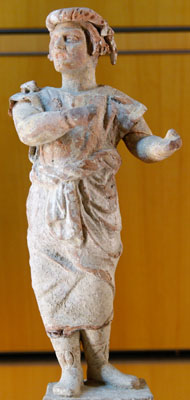
Terracotta figurine of a New
Comedy actor (tympanon
player). From Myrina, Mysia.
Late 3rd - 2nd century BC.
Museum of Fine Arts of Lyon.
Inv. No. E 272-54.
Photo: Marie-Lan Nguyen
|
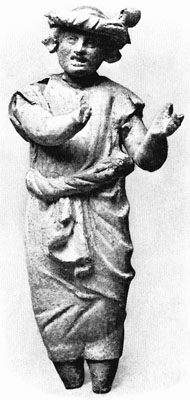
Hellenistic terracotta figurine
of a tympanon player from
Myrina. Height 18 cm.
Pergamon Museum, Berlin.
Inv. No. TK 7969.
|
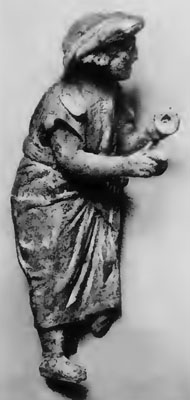
Hellenistic terracotta figurine
of a cymbal player from Myrina.
2nd century BC. Height 18 cm.
National Archaeological
Museum, Athens. Inv. No. 5060
(Ioannis Misthos Collection 543).
|
The cymbal player (right) "Very likely depicts the
stock character of a young flatterer (Kolax)".
Nikolaos Kaltsas, The National Archaeological Museum,
page 392. John S. Latsis Public Benefit Foundation and
EFG Eurobank Ergasias S.A., Athens, 2007.
Image sources
Centre: Carl Robert, Die Masken der neueren attischen
Komoedie, Seite 66, Fig. 87. Max Niemeyer, Halle, 1911.
At the Internet Archive.
Right: Magarete Bieber, Die Denkmäler zum
Theaterwesen im Altertum, plate 100,3. Walter de
Gruyter, Berlin & Leipzig 1920. At the Internet Archive.
See also:
Reinhard Kekule von Stradonitz, Die antiken Terrakotten,
Band III, 2: Franz Winter, Die Typen der figürlichen Terrakotten
Teil II, Seite 426. W. Spemann, Berlin & Stuttgart, 1903.
At Heidelberg University Digital Library. |
|
| |
3. Marx, Plautus and Menander
See:
Friedrich Marx, Plauti Cistellaria Manandrea in Dioscuridis Mosaico Pompeiana. In: Rheinisches Museum für Philologie, Band 79 (1930), pages 197-208. J.D. Sauerländer's Verlag, Bad Orb. In Latin at the University of Köln.
Dorothy K. Lange, The identification of Plautus' Cistellaria with Menander's Synaristosai. In: The Classical Journal, Volume 70, No. 3 (February - March 1975), pages 30-32. The Classical Association of the Middle West and South, Inc. (CAMWS). At jstor. In English.
T. Maccius Plautus, Cistellaria, or The Casket. Henry Thomas Riley, The comedies of Plautus. G. Bell and Sons, London, 1912. At Perseus Digital Library.
4. The Dioskourides scenes and the mosaics from the House of Menander, Mytilene
The "House of Menander" was named after the large floor mosaics discovered there during excavations in 1961-1962. The results were first published in 1970. The mosaics include busts of Menander and Thaleia, the Muse of comedy, a comic mask and a sceptre, as well as 11 emblemata with scenes from Menander plays, including Theophoroumene and Synaristosai. They are now in the Archaeological Museum of Mytilene.
The play scenes are nowhere near as finely executed as the Naples mosaics. The images are reversed (mirrored, i.e. the figures on the left on the Naples panels are on the right on the Mytiline mosaics) and differ in a number of details.
See:
Katherine M. D. Dunbabin, Mosaics of the Greek and Roman World, pages 44-47, and figures 44 and 45. Cambridge University Press, 1999.
S. Charitonidis, L. Kahil, R. Ginouvès, Les Mosaïques de la Maison de Ménandre à Mytilène. Francke Verlag, Bern, 1970.
Eric Csapo, Mise en scène théâtrale, scène de théâtre artisanale: les mosaïques de Ménandre à Mytilène, leur contexte social et leur tradition iconographique. In: Pallas, Année 1997, Volume 47, Numéro 1, pages 165-182. At persee.fr.
According to BrillOnline, the Mytilene mosaic inscriptions (labels of comedies of Menander) are listed in Supplementum Epigraphicum Graecum as SEG 49-1091.
See: dx.doi.org/10.1163/1874-6772_seg_a49_1091 at brillonline.com.
Other scenes from Menander's plays have been found on mosaics at: Kastelli Kissamos, Crete (unpublished); Chania, Crete; Ulpia Oescus, Bulgaria. There are also scenes from Menander on wall paintings at Ephesus (Hanghaus 2).
See: Volker Michael Strocker, Theaterbilder aus Ephesos. In: Gymnasium 80 (1973), pages 362-380, plates XVI-XX. Sonderdrucke aus der Albert-Ludwigs-Universität Freiburg.
An inscribed mosaic panel (1,75 x 1,5 metres) signed by Zosimos (Ζώσιμος), discovered in 2000 at ancient Zeugma on the Euphrates (Ζεῦγμα, near Gaziantep, southern Turkey), and dated to around 200 AD, shows the same scene of the women at lunch from Menander's Synaristosai, but in a very different, non-dramatic style. Zosimos may have been the Zosimos of Samosata whose signature is on a mosaic of Aphrodite on a shell and two Tritons, also found at Zeugma.
See:
News, 6th August 2000
and
information about the discovery of the Zosimos mosaic,
at thehumanjourney.net, the website of the archaeological rescue project at Zeugma.
Niall W. Slater, The evidence of the Zeugma Synaristosai mosaic for imperial performance of Meander. In: S. Douglas Olson (editor), Ancient Comedy and Reception: Essays in Honor of Jeffrey Henderson, pages 366-374. Walter de Gruyter, Berlin/Boston, 2014.
Four more inscribed mosaic panels illustrating scenes of Menander's comedies were excavated by archaeologists in 2007 at ancient Daphne (modern Harbiye), once a wealthy suburb of Antioch on the Orontes (today Antakya, Turkey). These include scenes from Theophoroumene (act 3) and Synaristosai (act 1).
Kathryn Gutzwiller and Ömer Çelik, New Menander Mosaics from Antioch. In: American Journal of Archaeology, Volume 116, No. 4 (October 2012), pages 573-623. Archaeological Institute of America, 2012. At academia.edu. An excellent article which comprehensively examines the evidence concerning the various ancient images (mosaics, wall paintings, drawings on papyrus) depicting scenes from Menander's plays, including those found at Daphne, Pompeii, Mytilene, Zeugma, Ephesus, Delos and Chania, with good illustrations. |
| |
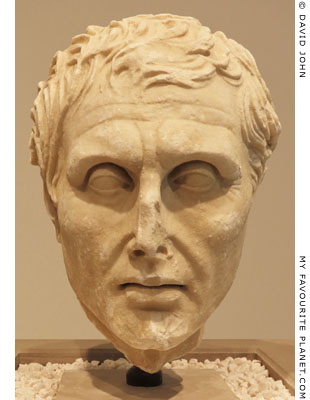
Marble portrait head of Menander
from Corfu.
Roman Imperial period, first half of the
2nd century AD. One of the best preserved
examples of the type believed to be copies
of the bronze statue by Kephisodotos and
Timarchos from the Theatre of Dionysos,
Athens. Height 29.5 cm.
Corfu Archaeological Museum. Inv. No. 133. |
| |
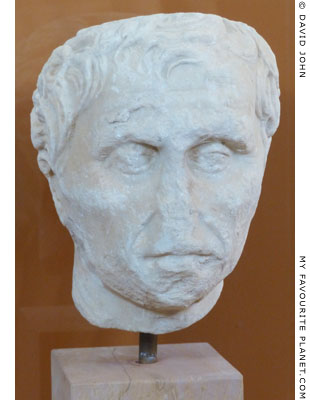
A marble portrait head of Menander.
1st - 2nd century AD. Provenance unknown.
The head was stolen along with a large
number of antiquities during a violent
burglary of the museum on 12 April 1990.
Recovered by police, it was returned
to the museum on 25 January 2001.
Corinth Archaeological Museum. |
| |
5. Music ancient and modern
Although the aulos is thought to have had a reed mothpiece, like the modern oboe or clarinet, its name is is often translated as "flute".
The ancient combination of aulos, tympanon and cymbals, and variants of these instruments, are still used in traditional music, usually to accompany dancing, in the Balkans, Greece, Turkey, Central Asia, the Levant and North Africa. In most cases the aulos has been replaced by a clarinet or other wind instrument, and the ensembles are now often augmented by an accordion or electronic keyboard. Although the musicians are today are no longer itinerant, strictly-speaking, many still travel around local towns and villages to play at weddings and other religious and secular festivities.
See, for example:
Istanbul wedding dance and Come on, baby, light my fire, at The Cheshire Cat Blog.
6. Menander's Theophoroumene and Kybele
Several lines from Theophoroumene have been preserved in papyrus PSI 1280 (1st - 2nd century AD) from Oxyrhynchus in Egypt. In one line, a character, probably the youth Lysias, suggests testing the girl to see if she is faking divine possession by playing to her "that song for the mother of the gods, or rather the Corybants’ song" outside the door to an inn. Another papyrus, PSI 1480 (1st century BC - 1st century AD), also thought to be a fragment of the play, includes comic dialogue and a song about Kybele, which has also been described as a hymn to Kybele.
See:
Sebastiana Nervegna, Menander's Theophoroumene between Greece and Rome. In: The American Journal of Philology, Volume 131, No. 1 (Spring 2010), pages 23-68. The Johns Hopkins University Press. At jstor.org.
Information about papyrus PSI 1280: www.psi-online.it/documents/psi;12;1280
William Geoffrey Arnott (editor and translator), Menander Volume II. Theophoroumene (The Demonic Girl), pages 49-80. Loeb Classical Library. Harvard University Press, 1996. |
|
|
| |
Photos and articles © David John,
except where otherwise specified. |
More photos and information
about mosaics
on My Favourite Planet
Hellenistic mosaics in Pella, Macedonia, Greece
The "Alexander Mosaic" from Pompeii, depicting
Alexander the Great in battle with King Darius III:
Alexander the Great
A mosaic of Dionysos and "Sleeping Ariadne"
from Ephesus, now in the
Izmir Archaeological Museum, Turkey:
Selcuk photo gallery 2
A Hellenistic mosaic, signed by Hephaistion,
from Pergamon, Turkey, now in
the Pergamon Museum, Berlin:
Pergamon photo gallery 2
Ancient mosaics depicting the Gorgon Medusa
Mosaics at Dion Archaeological Site,
Macedonia, Greece:
Dion: garden of the Gods
at the Cheshire Cat Blog
"Choklakia" mosaics in Kastellorizo, Greece:
Kastellorizo photo gallery
Mosaics of Saint John the Theologian,
on Patmos, Greece:
Patmos photo gallery
Modern mosaic commemorating Saint Paul
the Apostle's visit to Veria, Macedonia, Greece:
Veria photo gallery
See also a mosaic mural made
by the author of this guide:
davidjohnberlin.de
|
|
| |
 |
Visit the My Favourite Planet Group on Facebook.
Join the group, write a message or comment,
post photos and videos, start a discussion... |
|
|
| |
|
|
| |
| |
 |
| |
 |
| |
 |
| |
 |
| |
 |
| |
 |
| |
George Alvanos
rooms in
Kavala's historic Panagia District
Anthemiou 35,
Kavala, Greece
kavalarooms.gr
|
| |
Olive Garden Restaurant
Kastellorizo,
Greece
+30 22460 49 109
kastellorizo.de
|
| |
Papoutsis
Travel Agency
Kastellorizo,
Greece
+30 22460 49 286
greeklodgings.gr
|
| |
|